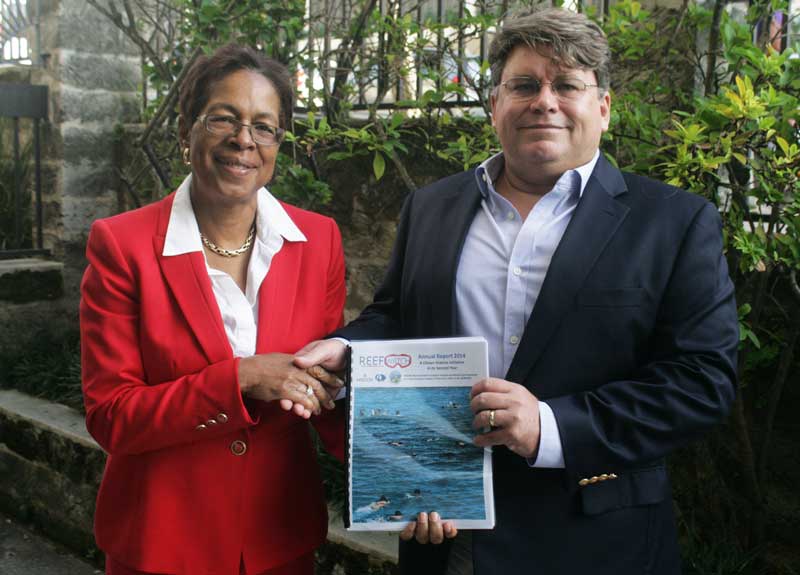2014 Reef Watch Report Presented To Minister
The 2014 Reef Watch Report was formally presented by the BZS to Minister for Health, Seniors and Environment Jeanne Atherden and the Ministry’s Permanent Secretary Kevin Monkman, today [Dec 17].
The report is a culmination of the data collected during Reef Watch 2014, which was held on Saturday, June 28, and supported by lead sponsor, Hiscox.
During the one-day event, members of the community were invited to participate in an island-wide effort to monitor the health of Bermuda’s reefs in support of the Bermuda Reef Ecosystem Analysis and Monitoring [BREAM] programme, led by chief scientist, Dr. Thaddeus Murdoch.
“It was great to spend time with all the Reef Watch participants and to hear about their snorkeling experiences during Reef Watch Day 2014,” Dr. Murdoch said. “I am really pleased with the information they collected.
“Their efforts confirmed for a second year that our reef corals and plant-eating fishes remain healthy. Worryingly, our commercial fish, such as grouper and snapper, were in very low numbers across most reefs again this year. It is important that all parts of the reef are healthy if they are to protect us from big storms like Hurricane Gonzalo, and to continue to provide food for future generations of Bermudian residents.”
Dr. Murdoch presents the 2014 Reef Watch Report to the MinisterAtherden. Photo by Sara Westhead
The Bermuda Zoological Society [BZS] said, “Not only was the event a huge success as a fundraiser for continued reef protection and support of BREAM, it also provided scientists with an amazing amount of data that would normally take months to gather – including counting more than 4000 individual fishes classified into nine main categories based on their important jobs on the reef. More than 20 teams participated in the day’s events, surveying 40 different patches of reefs located across Bermuda’s north lagoon.
“The surveys were conducted utilizing hula-hoops to help measure coral health and the amount of seaweed and mobile reef inhabitants, like lobsters, found on the lagoonal reefs.
“Predatory fish, like groupers and snappers, are important in controlling numbers of coral-killing damselfish that live on the reef. Parrotfish, doctor fish, and chubs eat underwater plants that fight for space with reef corals.
“Damselfish are native members of the reef community, but when left unchecked, can cause damage to corals by growing turf algae gardens on coral skeletons. A healthy reef has lots of predatory fish and plant-eating [herbivorous] fish, and few damselfish.
“Analysis of the 2014 Reef Watch survey indicates some good news and some bad news. While herbivorous fish were highly abundant on more than 50% of the reefs surveyed and only rare on the inshore reefs, where they do not naturally live.
“However, we found that there were too few predators on reefs – predators were only found to be “abundant” on 10% of reefs, and “highly abundant” on only 7% of reefs. Conversely, over 80% of reefs were seen to have very low to no predators.
“Probably a consequence of too few predatory fish being seen on the reefs, damselfish were seen to be very abundant on more than 50% of reefs, and abundant on another 30%. Only 17% of the reefs were seen to have the low numbers of damselfish that are normally expected to see if fish populations and coral reefs were in a healthy condition. This pattern of too few predators and too many damselfish was also seen in 2013.”
A full copy of the 2014 Reef Watch Survey Report can be found online for download here [PDF].
Read More About
Category: All, Environment


